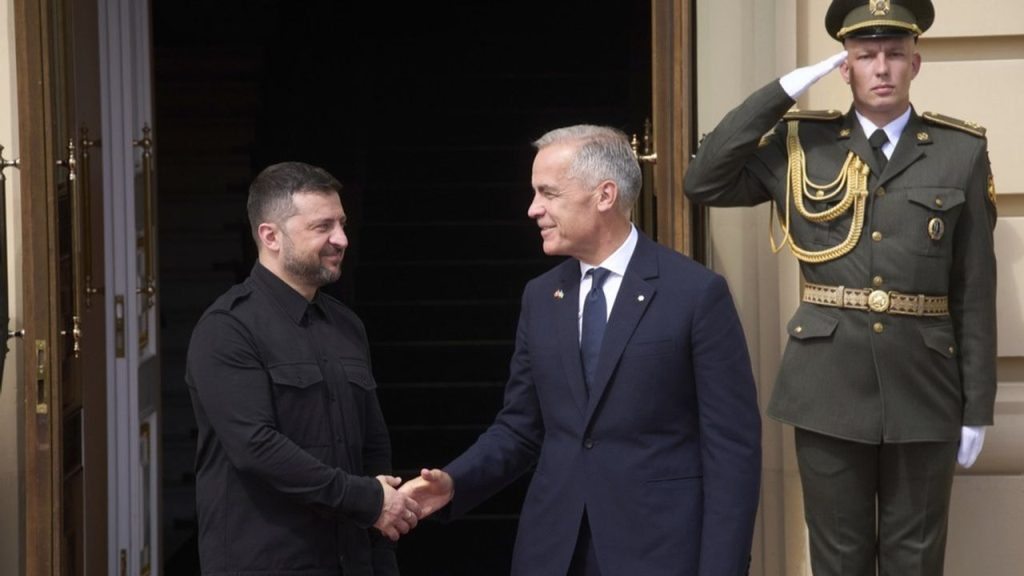Mark Carney’s European Tour: A Strategic Dive into Militarism and Imperialism
Prime Minister Mark Carney’s recent tour across Europe, which spanned from Kiev to Warsaw and Berlin to Latvia, signals a significant shift in Canadian foreign policy. With the looming specter of a third imperialist world war, Carney’s trip underscores the new Liberal government’s intentions to solidify Canada’s economic and military ties with major European powers.
A Strong Start in Ukraine
Kicking off the tour on August 24, Ukrainian Independence Day, Carney announced a staggering allocation of C$2 billion in new military aid for Ukraine. This funding is set to bolster Ukraine’s defense against Russian aggression, with specific allocations including C$835 million for equipment (from armoured vehicles to drones), C$680 million for air defence systems prioritizing NATO’s requests, and substantial investments in electronic warfare capabilities. This financial support, however, is coupled with a mere C$31 million directed toward humanitarian aid, raising questions about the true motivations of Canadian military involvement.
In his remarks in Kiev, Carney echoed sentiments that resonate within the imperialist narrative: “Ukraine is at the frontline of the struggle for democracy and freedom.” Such rhetorical flourishes aim to paint a picture of moral imperative while preparing the Canadian public for a sustained military engagement.
Engaging Poland for Security Partnership
Transitioning from Ukraine to Poland, Carney emphasized that Canada would not shy away from providing security guarantees for Ukraine, including the possible deployment of Canadian troops. His assurances about Canadian military personnel’s current role in training Ukrainian soldiers demonstrate a deepening commitment to NATO’s agenda. The implications of such a move are dire; it places Canada in direct contention with Russian interests, all while aligning itself more closely with U.S. geopolitical strategies in Eastern Europe.
The visit to Warsaw culminated in the establishment of a strategic partnership with Poland, creating pathways for Canadian firms to engage in Europe’s military rearmament. This partnership signals Ottawa’s intent to tap into the €800 billion investment pledged by EU member states for defense spending, intensifying military operations on NATO’s eastern flank.
Strengthening Economic Ties in Germany
Berlin became a focal point for Carney’s discussions on resource and energy cooperation, particularly involving natural gas exports. With Germany facing an urgent need to replace lost Russian gas supplies, Canadian liquefied natural gas (LNG) emerged as a crucial alternative. Carney’s commitment to developing infrastructure that facilitates these energy exports signals a broader ambition to position Canada as a key player in the critical minerals market essential for defense and high-tech sectors.
The discussions included signing a “Joint Declaration of Intent” to co-fund critical minerals projects, centering on defense and renewable energy resources. This aligns Canada’s economic strategy with its military ambitions, blending commercial interests with geopolitical maneuvering.
On the Baltic Front in Latvia
In Latvia, Carney announced a three-year extension of Operation Reassurance, reinforcing Canada’s military presence in the region. As the "framework nation" of a 3,000-strong multinational brigade, with an increased contribution of Canadian Armed Forces personnel, Canada is now positioned within striking distance of Russian territory. The reinforcement of NATO capabilities here is not just a show of force but a significant escalation in the geopolitical chess game being played in Eastern Europe.
His remarks underscored a futile yet ambitious attempt to establish a deterrence strategy against Russia: “To secure lasting peace in Ukraine and Europe, we must deter and fortify.”
Behind the Political Choreography
The calculated timing of Carney’s engagements hints at strategic positioning against the U.S. under Donald Trump’s administration, which has increasingly complicated Canada’s traditional role as an ally. The backdrop of Carney’s tour included ongoing discussions with Trump about redefining the Canada-U.S. economic and security relationship, marking a pivot in Canadian policy that has historically leaned heavily on American partnership.
As tensions grow and competition for resources intensifies, Ottawa’s attempts to balance its relationships with both Washington and European allies draw a stark line between opportunism and strategic necessity.
The Broader Implications for Workers
The implications of such militaristic and imperialist policies go beyond geopolitical maneuvering; they signal a coming assault on social spending in Canada. With the government poised to increase military spending to 5% of GDP by 2035, the financial burden on the working class becomes increasingly evident. Such shifts threaten to drain public funds from essential services, result in cuts to healthcare, and exacerbate the existing crisis in social services.
As the Canadian government leans heavily into its military-industrial complex, the necessity for workers to recognize the interplay between war, austerity, and their rights becomes crucial. This reality necessitates a political reawakening and mobilization against the forces of capitalism, which threaten both social welfare and global peace.
The strategic alignments Carney has nurtured reflect a broader and more troubling narrative in Canadian politics, one that prioritizes imperial ambitions over the welfare of its citizens and the international working class.

